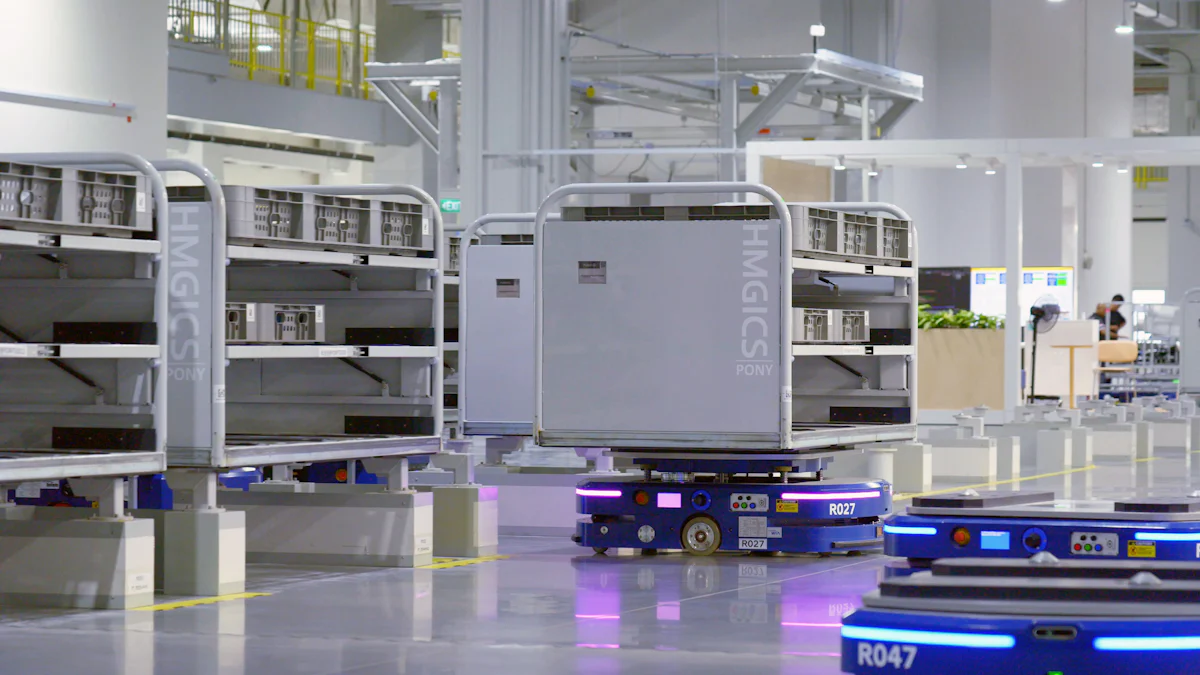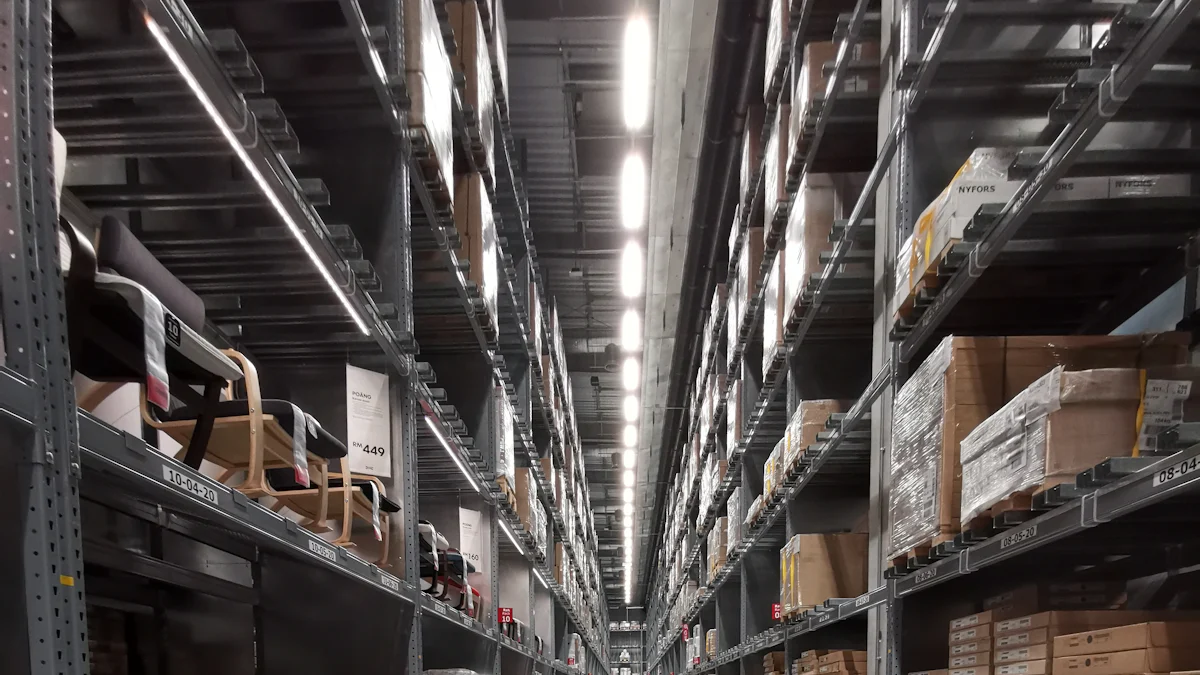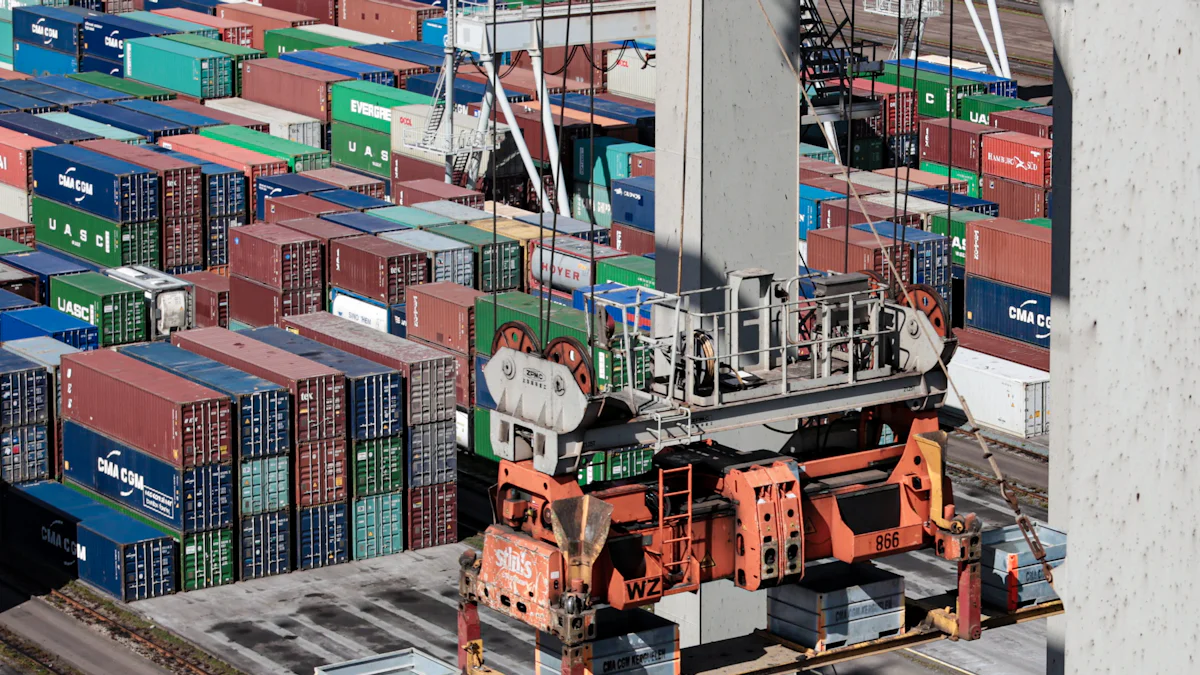Exploring the Impact of Intelligent Warehousing Systems in Global Markets

An intelligent warehousing system revolutionizes storage and distribution processes. Warehousing plays a crucial role in global trade by ensuring efficient inventory management and timely deliveries. Technological advancements have transformed warehouses into smart hubs. Companies spent an average of 7.9% of revenue on technology in 2020. The global warehouse automation market is projected to exceed $30 billion by 2025. Robotics and automation spending reached $3.6 billion in 2020. These investments highlight the growing importance of intelligent systems in enhancing operational efficiency and competitiveness in international markets.
Key Components of Intelligent Warehousing Systems

Automation Technologies
Robotics in Warehousing
Robotics have transformed warehousing operations. Robots handle tasks like sorting, packing, and transporting goods. These machines increase efficiency and reduce labor costs. Warehouses use robots to optimize workflows and enhance productivity. Robots improve safety by handling hazardous materials. The integration of robotics leads to significant cost savings.
Automated Storage and Retrieval Systems (AS/RS)
Automated Storage and Retrieval Systems (AS/RS) streamline inventory management. These systems automate the storage and retrieval of goods. AS/RS enhances accuracy and speed in order fulfillment. Warehouses benefit from reduced labor costs and increased storage capacity. The implementation of AS/RS improves operational efficiency.
Data Analytics and IoT
Role of Big Data in Warehousing
Big data plays a crucial role in modern warehousing. Warehouses analyze large volumes of data for decision-making. Data analytics helps optimize inventory levels and reduce waste. Companies use data to forecast demand and manage supply chains. Big data enhances warehouse operations by providing actionable insights.
Internet of Things (IoT) in Inventory Management
The Internet of Things (IoT) revolutionizes inventory management. IoT devices provide real-time data on inventory levels. Warehouses use IoT to track goods and monitor conditions. IoT technology reduces errors and improves accuracy in inventory management. The adoption of IoT leads to enhanced efficiency and reduced operating costs.
Artificial Intelligence and Machine Learning
Predictive Analytics for Demand Forecasting
Artificial Intelligence (AI) enables predictive analytics in warehousing. AI analyzes historical data to forecast demand accurately. Warehouses use predictive analytics to optimize inventory levels. This approach reduces stockouts and overstock situations. AI-driven demand forecasting enhances supply chain efficiency.
AI-driven Decision Making in Logistics
AI-driven systems transform logistics decision-making. AI analyzes data to optimize transportation routes and schedules. Warehouses use AI to improve delivery times and reduce costs. AI-driven decision-making enhances operational efficiency and customer satisfaction. The integration of AI in logistics leads to smarter and more agile supply chains.
Benefits of Intelligent Warehousing Systems
Operational Efficiency
Reduction in Manual Labor
Intelligent warehousing systems significantly reduce manual labor. Automation technologies handle repetitive tasks. Robots and automated systems perform sorting, packing, and transporting. This shift allows human workers to focus on strategic activities. Companies experience increased productivity and reduced labor costs.
Faster Order Fulfillment
Automated systems enable faster order fulfillment. Intelligent warehousing systems streamline picking and packing processes. Automated Storage and Retrieval Systems (AS/RS) enhance speed and accuracy. Companies achieve quicker response times to customer demands. Improved efficiency leads to higher customer satisfaction.
Cost Savings
Lower Operational Costs
Intelligent warehousing systems lower operational costs. Automation reduces the need for extensive human labor. Companies save money on wages and benefits. Warehouse management software optimizes resource allocation. Businesses report cost reductions of up to 30% with automation.
Energy Efficiency
Energy efficiency improves with intelligent systems. Automated systems use energy more effectively. Smart technologies monitor and adjust energy consumption. Companies reduce their carbon footprint and utility expenses. Energy-efficient operations contribute to overall cost savings.
Enhanced Customer Satisfaction
Improved Accuracy in Deliveries
Intelligent warehousing systems improve delivery accuracy. Advanced technologies minimize errors in order processing. Accurate inventory management ensures correct shipments. Customers receive the right products on time. Enhanced accuracy boosts customer trust and loyalty.
Real-time Tracking and Transparency
Real-time tracking and transparency become possible with intelligent systems. Internet of Things (IoT) devices provide continuous updates. Customers track orders from warehouse to delivery. Transparency builds customer confidence in the supply chain. Real-time data enhances communication and service quality.
Challenges in Implementing Intelligent Warehousing Systems
High Initial Investment
Cost of Technology and Infrastructure
Implementing intelligent warehousing systems requires substantial financial resources. Companies must invest in advanced technologies and infrastructure. Robotics, automation, and IoT devices demand significant capital. The cost of these technologies can deter small and medium-sized enterprises. Large corporations often have the financial capacity to absorb these expenses.
Training and Skill Development
Intelligent warehousing systems necessitate specialized skills. Employees require training to operate new technologies effectively. Training programs incur additional costs for businesses. Companies must allocate resources for continuous skill development. The workforce needs to adapt to rapidly evolving technological landscapes.
Data Security Concerns
Protecting Sensitive Information
Intelligent warehousing systems handle vast amounts of data. Protecting sensitive information becomes a priority. Data breaches can lead to severe financial and reputational damage. Companies must implement robust security measures. Encryption and access controls are essential for safeguarding data integrity.
Cybersecurity Measures
Cybersecurity threats pose significant risks to warehousing systems. Hackers target vulnerabilities in connected devices. Companies must invest in cybersecurity solutions to mitigate risks. Regular security audits and updates are crucial. A proactive approach ensures the protection of critical assets.
Integration with Existing Systems
Compatibility Issues
Integrating intelligent systems with existing infrastructure presents challenges. Compatibility issues arise when merging old and new technologies. Companies face difficulties in achieving seamless integration. Customization may be necessary to ensure system interoperability. Businesses must evaluate compatibility before implementation.
Transition and Change Management
Transitioning to intelligent warehousing systems requires careful planning. Change management strategies facilitate smooth adaptation. Employees may resist changes to established workflows. Effective communication and training alleviate resistance. Companies must prioritize change management to ensure successful implementation.
Applications in Global Markets

Case Studies
Successful Implementation in Retail Sector
Retailers have embraced intelligent warehousing systems to enhance operational efficiency. A prominent retail giant implemented robotics and automation technologies. These technologies streamlined inventory management and improved order fulfillment. The retailer reported a 25% increase in productivity. The integration of smart systems reduced labor costs by 20%. The retailer achieved faster delivery times, enhancing customer satisfaction.
Impact on E-commerce Warehousing
E-commerce companies have adopted intelligent warehousing systems to meet growing consumer demands. An e-commerce leader integrated IoT devices and data analytics. This integration provided real-time inventory tracking and demand forecasting. The company experienced a 30% reduction in stockouts. The implementation of smart systems improved accuracy in deliveries. The e-commerce company enhanced its competitive edge in the market.
Market Trends
Growth in Adoption Rates
The adoption of intelligent warehousing systems has surged globally. Companies recognize the benefits of automation and data-driven decision-making. The global smart warehousing market is projected to grow significantly. Businesses invest in advanced technologies to optimize operations. The demand for intelligent systems continues to rise across various industries.
Regional Variations in Implementation
Regional variations exist in the implementation of intelligent warehousing systems. European markets focus on improving inventory management. Companies in Asia prioritize automation to enhance productivity. North American businesses emphasize data security and integration. Each region adapts intelligent systems to meet specific market demands. The global landscape showcases diverse approaches to smart warehousing.
JUSDA's Role in Intelligent Warehousing Systems
JusLink Platform
Real-time Collaborative Platforms
JUSDA has developed the JusLink Platform, which plays a pivotal role in enhancing intelligent warehousing systems. The platform facilitates real-time collaboration among suppliers, manufacturers, and customers. This collaboration ensures seamless communication and coordination across the supply chain. The platform's advanced technology supports efficient resource utilization and precise decision-making. Businesses benefit from improved operational efficiency and reduced lead times.
Integration with Client Systems
The JusLink Platform integrates seamlessly with client systems, providing customized solutions tailored to specific business needs. This integration enhances the flexibility and scalability of warehousing operations. Businesses can scale their operations without logistical constraints. The platform's adaptability allows for efficient handling of diverse product categories. Clients experience enhanced inventory management and streamlined operations through this integration.
Global Presence and Achievements
Service Points and Warehousing Capacity
JUSDA boasts a comprehensive network of service points and warehousing facilities worldwide. The company operates over 155 service points and more than 2.5 million square meters of warehousing space. This extensive network ensures efficient logistics operations across various regions. Businesses benefit from seamless storage and distribution services, enhancing their market reach. The global presence of JUSDA underscores its commitment to supporting international markets with intelligent warehousing systems.
Recognitions and Certifications
JUSDA has received numerous recognitions and certifications for its excellence in supply chain management. The company holds prestigious certifications such as ISO9001 and AEO enterprise senior certification. These certifications ensure compliance with international standards and enhance the credibility of JUSDA's services. The company's achievements include listings on the Hurun Global Unicorn List and recognition by the Harvard Business Review. These accolades highlight JUSDA's dedication to innovation and excellence in intelligent warehousing systems.

JUSDA Solutions
To provide you with professional solutions and quotations.
Intelligent warehousing systems have transformed global supply chains. Automation and advanced technologies enhance efficiency and accuracy. These systems reduce costs and improve safety. The future of warehousing will see increased use of AI, robotics, and data analytics. These innovations will drive efficiency and competitiveness. Businesses must embrace these advancements for success. Investing in technology and automation is strategic. This investment optimizes inventory management and order fulfillment. Companies achieve seamless workflows and reduced operational expenses. Adopting cutting-edge solutions ensures a competitive edge in the digital market.
See Also
Tomorrow's Logistics Revolution: AI Transforming Supply Chains
Big Data Revealed: Supply Chain Enhancement Unveiled
Warehouse Productivity Enhanced: Robotics Powering Logistics
Explaining Warehousing Automation: Boosting Efficiency with Robotics
